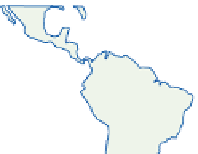Geoscience Reference
In-Depth Information
Pressure gradients are also generally weak, except
for tropical storm systems. For these reasons,
tropical weather maps usually depict streamlines,
not isobars or geopotential heights. Second,
temperature gradients are characteristically
weak. Spatial and temporal variations in moisture
content are much more significant diagnostic
characteristics of climate. Third, diurnal land/sea
breeze regimes play a major role in coastal
climates, in part as a result of the almost constant
day length and strong solar heating. There are also
semi-diurnal pressure oscillations of 2-3mb, with
minima around 04:00 and 16:00 hours and
maxima around 10:00 and 22:00 hours. Fourth,
the annual regime of incoming solar radiation,
with the sun overhead at the equator in March and
September and over the Tropics at the respective
summer solstices, is reflected in the seasonal
variations of rainfall at some stations. However,
dynamic factors greatly modify this conventional
explanation.
northeast and southeast trades was identified as
the Intertropical Front (ITF). Over continental
areas such as West Africa and South Asia, where
in summer hot, dry continental tropical air
meets cooler, humid equatorial air, this term has
some limited applicability (
Figure 11.1
). Sharp
temperature and moisture gradients may occur,
but the front is seldom a weather-producing
mechanism of the mid-latitude type. Elsewhere in
low latitudes, true fronts (with a marked density
contrast) are rare.
Recognition of the significance of wind field
convergence in tropical weather production in
the 1940-1950s led to the designation of the
Trade Wind convergence as the Intertropical
Convergence Zone (ITCZ). This feature is
apparent on a mean streamline map, but areas of
convergence grow and decay, either
in situ
or
within disturbances moving westward (see
Plate
11.1
), over periods of a few days. Moreover,
convergence is infrequent even as a climatic
feature in the doldrum zones (see
Figure 7.13
).
Satellite data show that over the oceans the
position and intensity of the ITCZ varies greatly
from day to day.
The ITCZ is predominantly an oceanic feature
where it tends to be located over the warmest
surface waters. Hence, small differences of sea
surface temperature may cause considerable
changes in the location of the ITCZ. A sea surface
temperature of at least 27.5
A THE INTERTROPICAL
CONVERGENCE
The tendency for the Trade Wind systems of the
two hemispheres to converge in the Equatorial
(low pressure) Trough has already been noted (see
Chapter 6B
). Views on the exact nature of this
feature have been subject to continual revision.
From the 1920s to the 1940s, the frontal concepts
developed in mid-latitudes were applied in the
tropics, and the streamline confluence of the
C seems to provide
a threshold for organized convective activity;
above this temperature organized convection is
°
30°
180°W
90°
0°
90°
180°E
15°
AUG
AUG
FEB
0°
FEB
15°
ITC cloud bands
ITF over land
FEB
30°S
Figure 11.1
The position of the Equatorial Trough (Intertropical Convergence Zone or Intertropical Front in some
sectors) in February and August. The cloud band in the southwest Pacific in February is known as the South Pacific
Convergence Zone; over South Asia and West Africa the term Monsoon Trough is used.
Sources: After Saha (1973), Riehl (1954) and Yoshino (1969).


































































